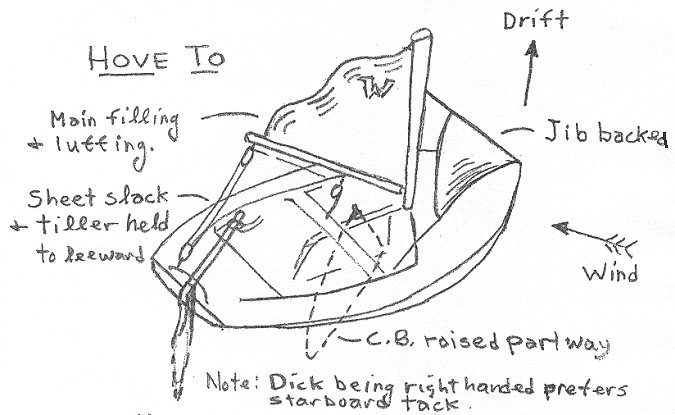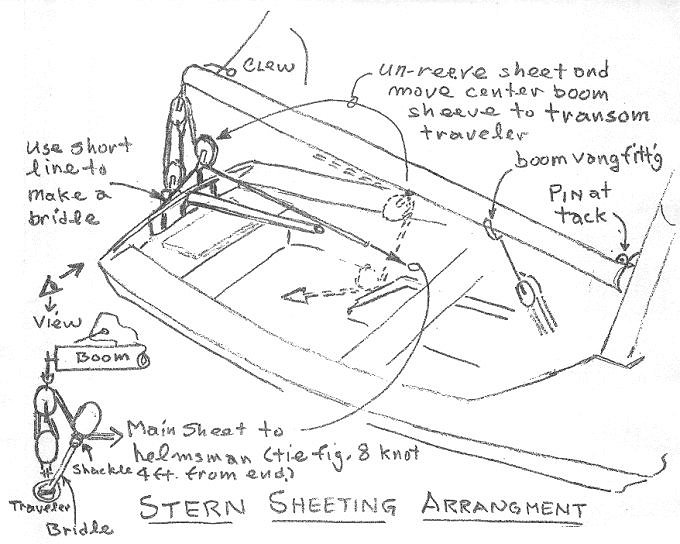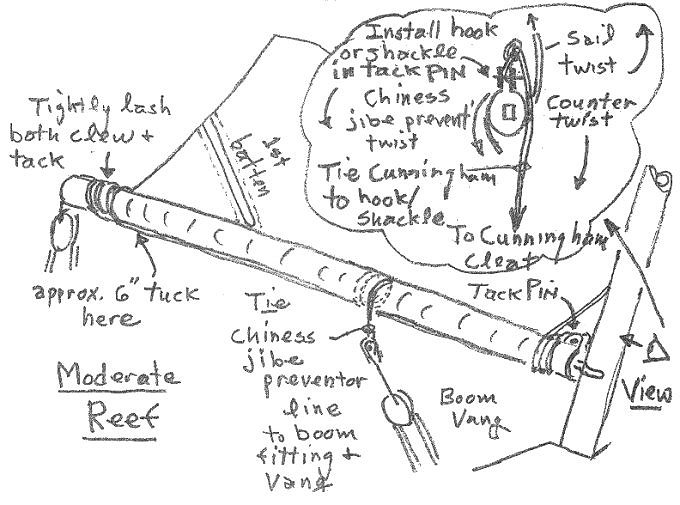|
by Dick Harrington (06/29/00) Cruising sailors are aware that a day will come when they will need to be able to reduce the size of the mainsail. The most common and popular method of doing this is slab reefing, sometimes referred to as "jiffy reefing”. This requires the installation (by a sailmaker) of reefing points (grommets) in the sail. There are usually two rows of reefing points, providing for a moderate reef and a deep reef. This system is called “jiffy” because, when properly set up (reefing lines rigged on the boom, etc.) reefing can be accomplished very quickly--in a couple of minutes or less. A second system which remains popular with some UK and Scandinavian Wayfarers is roller reefing, where the sail is wrapped around the boom. The design of the gooseneck on the Wayfarer makes this easy to do. This system has some advantages as well as disadvantages compared to slab reefing. Some well known and highly experienced Wayfarer sailors actually prefer it. Frank Dye uses a roller furling genoa and slab reefing on the main. However, when Frank gets caught out in some really heavy stuff and is still overpowered after reefing down to the second reef, he will reduce sail further by taking two or three wraps around the boom. He combines roller reefing with slab reefing. Now this is reefing! Roller reefing requires all mainsheet blocks to be at the end of the boom and at the transom. The block located at the center of the boom and the block and jammer located on the back slope of the centerboard trunk, the typical setup over here, are not used. Sailors who regularly cruise and employ roller reefing have transom to end-of-boom sheeting as the standard. The jammer is mounted on the transom traveler (or horse). This is a perfectly good sheeting arrangement which unclutters the cockpit considerably, but it takes some getting used to. The two main disadvantages of roller reefing are:
Roller Reefing - step by step 1.
Heave
to – unless you have the luxury of doing your reefing in a
sheltered
area.  .....
2. Jib. If you are in a blow, or uncertain about conditions, take the jib down first. (It is convenient to leave the jib tack shackled at the bow and bundle & tie it on the foredeck to one of the deck handles.) Unshackle the halyard and make it fast. 3. Mainsail. Drop the main quickly to avoid starting the boat sailing when hauling in the boom. (Al’s note: This will be no problem if the board is full up!) Leaving a portion of the sail up, say about half, may help in maintaining hove to. Disconnect the boom vang. 4.
Changing
over to boom end sheeting. Un-reeve the mainsheet from the
jammer,
center boom block and any fairleads on the boom. Attach the center boom
block to transom traveler by means of a bridle made from a short piece
of thin but stout line. The ends of the bridle can be tied, using a
bowline,
around the traveler. Feed the loose end of the mainsheet through this
block
as shown in the diagram. Put a knot in the end of the mainsheet. A
figure
eight knot about 4 feet from the end of the sheet will keep it from
inadvertently
running out of the transom block. (Note: The lack of a jammer is not a
problem and is safer in heavy weather.)  ..... 5.
Boom
Vang. If possible, tie a 3 to 4 foot piece of thin but
strong
line to the boom vang fitting on the boom. This will become a “Chinese
jibe” preventer. 6.
Cunningham
Fitting. Install a shackle, hook, or loop of line, in the
pin
fitting on the boom (at the sail tack). This will serve as an
attachment
point for the Cunningham and will act to counter the twisting moment on
the gooseneck. Pull the outhaul tight. 7.
Rolling
The Sail. Begin rolling by taking a small tuck of
approximately
6" at the outboard end (clew) of the boom. This will keep the end of
the
boom from drooping too low. For a moderate reef, roll to the tip of the
first batten. For a deep reef, roll to the tip of the second batten.
Remove
battens, don't roll them in, and watch out for fiberglass slivers on
old
battens!  ..... 9. Hoist sail. Replace the boom in the gooseneck and tie the cunnigham line to the pin attachment point so as to counter the twisting moment imparted by the sail. (This will, we hope, save the gooseneck from breakage!) Raise the sail. Take up slack in the boom vang. 10. Go Sailing! End.
|